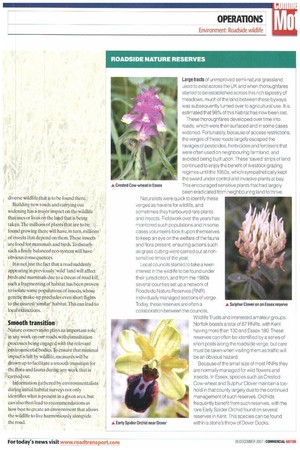ROADSIDE NATURE RESERVES Large tracts of unimproved semi-natural grassland used
Page 63

If you've noticed an error in this article please click here to report it so we can fix it.
to exist across the UK and when thoroughfares started to be established across this rich tapestry of meadows, much of the land between these byways was subsequently turned over to agricultural use. It is estimated that 98% of this habitat has now been lost.
These thoroughfares developed over time into roads, which were then surfaced and in some cases widened. Fortunately, because of access restrictions, the verges of these roads largely escaped the ravages of pesticides, herbicides and fertilisers that were often used on neighbouring farmland, and avoided being built upon. These 'saved' strips of land continued to enjoy the benefit of livestock grazing regimes until the 1950s, which sympathetically kept the sward under control and invasive plants at bay.
A Crested Cow-wheat in Essex This encouraged sensitive plants that had largely
been eradicated from neighbouring land to thrive.
Naturalists were quick to identify these verges as havens for wildlife, and sometimes they harboured rare plants and insects. Fieldwork over the years has monitored such populations and in some cases volunteers took it upon themselves to keep an eye on the welfare of the fauna and flora present, ensuring actions such as grass cutting were carried out at nonsensitive times of the year.
Local councils started to take a keen interest in the wildlife to be found under their jurisdiction, and from the 1980s several counties set up a network of Roadside Nature Reserves (FiNR), individually managed sections of verge.
Today, these reserves are often a A Sulphur Clover on an Essex reserve collaboration between the councils, Wildlife Trusts and interested amateur groups. Norfolk boasts a total of 67 RNRs, with Kent having more than 130 and Essex 180. These reserves can often be identified by a series of short posts along the roadside verge, but care must betaken when visiting them as traffic will be an obvious hazard.
Because of the small size of most RNRs they are normally managed for wild flowers and insects. In Essex, species such as Crested Cow-wheat and Sulphur Clover maintain a toehold in that county largely due to the continued management of such reserves. Orchids frequently benefit from such reserves, with the rare Early Spider Orchid found on several
. reserves in Kent. This species can be found A Early Spider Orchid near Dover within a stone's throw of Dover Docks.
































































































































































































